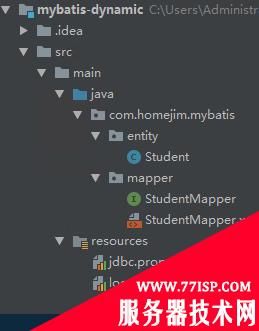2022-10-27 443
MyBatis 令人喜欢的一大特性就是动态 SQL。在使用 JDBC 的过程中, 根据条件进行 SQL 的拼接是很麻烦且很容易出错的。MyBatis 动态 SQL 的出现, 解决了这个麻烦。
MyBatis通过 OGNL 来进行动态 SQL 的使用的。目前, 动态 SQL 支持以下几种标签:

1、数据准备
为了后面的演示, 创建了一个 Maven 项目 mybatis-dynamic, 创建了对应的数据库和表
DROPTABLEIFEXISTS`student`; CREATETABLE`student`( `student_id`int(10)unsignedNOTNULLAUTO_INCREMENTCOMMENT'编号', `name`varchar(20)DEFAULTNULLCOMMENT'姓名', `phone`varchar(20)DEFAULTNULLCOMMENT'电话', `email`varchar(50)DEFAULTNULLCOMMENT'邮箱', `sex`tinyint(4)DEFAULTNULLCOMMENT'性别', `locked`tinyint(4)DEFAULTNULLCOMMENT'状态(0:正常,1:锁定)', `gmt_created`datetimeDEFAULTCURRENT_TIMESTAMPCOMMENT'存入数据库的时间', `gmt_modified`datetimeDEFAULTCURRENT_TIMESTAMPONUPDATECURRENT_TIMESTAMPCOMMENT'修改的时间', `delete`int(11)DEFAULTNULL, PRIMARYKEY(`student_id`) )ENGINE=InnoDBAUTO_INCREMENT=7DEFAULTCHARSET=utf8mb4COLLATE=utf8mb4_0900_ai_ciCOMMENT='学生表';
对应的项目结构

2、if 标签
if 标签是我们最常使用的。在查询、删除、更新的时候很可能会使用到。必须结合 test 属性联合使用。
2.1 在 WHERE 条件中使用 if 标签
这是常见的一种现象, 我们在进行按条件查询的时候, 可能会有多种情况。
2.1.1 查询条件
根据输入的学生信息进行条件检索
2.1.2 动态 SQL
接口函数
/** *根据输入的学生信息进行条件检索 *1.当只输入用户名时,使用用户名进行模糊检索; *2.当只输入邮箱时,使用性别进行完全匹配 *3.当用户名和性别都存在时,用这两个条件进行查询匹配的用 *@paramstudent *@return */ List<Student>selectByStudentSelective(Studentstudent);
对应的动态 SQL
<selectid="selectByStudentSelective"resultMap="BaseResultMap"parameterType="com.homejim.mybatis.entity.Student">
select
<includerefid="Base_Column_List"/>
fromstudent
where11=1
<iftest="name!=nullandname!=''">
andnamelikeconcat('%',#{name},'%')
</if>
<iftest="sex!=null">
andsex=#{sex}
</if>
</select>
在此 SQL 语句中, where 1=1 是多条件拼接时的小技巧, 后面的条件查询就可以都用 and 了。
同时, 我们添加了 if 标签来处理动态 SQL
<iftest="name!=nullandname!=''">
andnamelikeconcat('%',#{name},'%')
</if>
<iftest="sex!=null">
andsex=#{sex}
</if>
此 if 标签的 test 属性值是一个符合 OGNL 的表达式, 表达式可以是 true 或 false。如果表达式返回的是数值, 则0为 false, 非 0 为 true;
2.1.3 测试
@Test
publicvoidselectByStudent(){
SqlSessionsqlSession=null;
sqlSession=sqlSessionFactory.openSession();
StudentMapperstudentMapper=sqlSession.getMapper(StudentMapper.class);
Studentsearch=newStudent();
search.setName("明");
System.out.println("只有名字时的查询");
List<Student>studentsByName=studentMapper.selectByStudentSelective(search);
for(inti=0;i<studentsByName.size();i++){
System.out.println(ToStringBuilder.reflectionToString(studentsByName.get(i),ToStringStyle.MULTI_LINE_STYLE));
}
search.setName(null);
search.setSex((byte)1);
System.out.println("只有性别时的查询");
List<Student>studentsBySex=studentMapper.selectByStudentSelective(search);
for(inti=0;i<studentsBySex.size();i++){
System.out.println(ToStringBuilder.reflectionToString(studentsBySex.get(i),ToStringStyle.MULTI_LINE_STYLE));
}
System.out.println("姓名和性别同时存在的查询");
search.setName("明");
List<Student>studentsByNameAndSex=studentMapper.selectByStudentSelective(search);
for(inti=0;i<studentsByNameAndSex.size();i++){
System.out.println(ToStringBuilder.reflectionToString(studentsByNameAndSex.get(i),ToStringStyle.MULTI_LINE_STYLE));
}
sqlSession.commit();
sqlSession.close();
}
只有名字时的查询, 发送的语句和结果

查询的条件只发送了
where11=1andnamelikeconcat('%',?,'%')
只有性别时的查询, 发送的语句和结果

查询的条件只发送了
where11=1andsex=?
姓名和性别同时存在的查询, 发送的语句和结果

查询条件
where11=1andnamelikeconcat('%',?,'%')andsex=?
2.2 在 UPDATE 更新列中使用 if 标签
有时候我们不希望更新所有的字段, 只更新有变化的字段。
2.2.1 更新条件
只更新有变化的字段, 空值不更新。
2.2.2动态 SQL
接口方法 /** *更新非空属性 */ intupdateByPrimaryKeySelective(Studentrecord);
对应的 SQL
<updateid="updateByPrimaryKeySelective"parameterType="com.homejim.mybatis.entity.Student">
updatestudent
<set>
<iftest="name!=null">
`name`=#{name,jdbcType=VARCHAR},
</if>
<iftest="phone!=null">
phone=#{phone,jdbcType=VARCHAR},
</if>
<iftest="email!=null">
email=#{email,jdbcType=VARCHAR},
</if>
<iftest="sex!=null">
sex=#{sex,jdbcType=TINYINT},
</if>
<iftest="locked!=null">
locked=#{locked,jdbcType=TINYINT},
</if>
<iftest="gmtCreated!=null">
gmt_created=#{gmtCreated,jdbcType=TIMESTAMP},
</if>
<iftest="gmtModified!=null">
gmt_modified=#{gmtModified,jdbcType=TIMESTAMP},
</if>
</set>
wherestudent_id=#{studentId,jdbcType=INTEGER}
2.2.3 测试
@Test
publicvoidupdateByStudentSelective(){
SqlSessionsqlSession=null;
sqlSession=sqlSessionFactory.openSession();
StudentMapperstudentMapper=sqlSession.getMapper(StudentMapper.class);
Studentstudent=newStudent();
student.setStudentId(1);
student.setName("明明");
student.setPhone("13838438888");
System.out.println(studentMapper.updateByPrimaryKeySelective(student));
sqlSession.commit();
sqlSession.close();
}
结果如下

2.3 在 INSERT 动态插入中使用 if 标签
我们插入数据库中的一条记录, 不是每一个字段都有值的, 而是动态变化的。在这时候使用 if 标签, 可帮我们解决这个问题。
2.3.1 插入条件
只有非空属性才插入。
2.3.2 动态SQL
接口方法
/** *非空字段才进行插入 */ intinsertSelective(Studentrecord);
对应的SQL
<insertid="insertSelective"parameterType="com.homejim.mybatis.entity.Student">
insertintostudent
<trimprefix="("suffix=")"suffixOverrides=",">
<iftest="studentId!=null">
student_id,
</if>
<iftest="name!=null">
`name`,
</if>
<iftest="phone!=null">
phone,
</if>
<iftest="email!=null">
email,
</if>
<iftest="sex!=null">
sex,
</if>
<iftest="locked!=null">
locked,
</if>
<iftest="gmtCreated!=null">
gmt_created,
</if>
<iftest="gmtModified!=null">
gmt_modified,
</if>
</trim>
<trimprefix="values("suffix=")"suffixOverrides=",">
<iftest="studentId!=null">
#{studentId,jdbcType=INTEGER},
</if>
<iftest="name!=null">
#{name,jdbcType=VARCHAR},
</if>
<iftest="phone!=null">
#{phone,jdbcType=VARCHAR},
</if>
<iftest="email!=null">
#{email,jdbcType=VARCHAR},
</if>
<iftest="sex!=null">
#{sex,jdbcType=TINYINT},
</if>
<iftest="locked!=null">
#{locked,jdbcType=TINYINT},
</if>
<iftest="gmtCreated!=null">
#{gmtCreated,jdbcType=TIMESTAMP},
</if>
<iftest="gmtModified!=null">
#{gmtModified,jdbcType=TIMESTAMP},
</if>
</trim>
</insert>
这个 SQL 大家应该很熟悉, 毕竟是自动生成的。
2.3.3 测试
@Test
publicvoidinsertByStudentSelective(){
SqlSessionsqlSession=null;
sqlSession=sqlSessionFactory.openSession();
StudentMapperstudentMapper=sqlSession.getMapper(StudentMapper.class);
Studentstudent=newStudent();
student.setName("小飞机");
student.setPhone("13838438899");
student.setEmail("xiaofeiji@qq.com");
student.setLocked((byte)0);
System.out.println(studentMapper.insertSelective(student));
sqlSession.commit();
sqlSession.close();
}
对应的结果

SQL 中, 只有非空的字段才进行了插入。
3、choose 标签
choose when otherwise 标签可以帮我们实现 if else 的逻辑。一个 choose 标签至少有一个 when, 最多一个otherwise。
下面是一个查询的例子。
3.1 查询条件
假设 name 具有唯一性, 查询一个学生
3.2 动态SQL
接口方法
/** *-当studen_id有值时,使用studen_id进行查询; *-当studen_id没有值时,使用name进行查询; *-否则返回空 */ StudentselectByIdOrName(Studentrecord);
对应的SQL
<selectid="selectByIdOrName"resultMap="BaseResultMap"parameterType="com.homejim.mybatis.entity.Student">
select
<includerefid="Base_Column_List"/>
fromstudent
where11=1
<choose>
<whentest="studentId!=null">
andstudent_id=#{studentId}
</when>
<whentest="name!=nullandname!=''">
andname=#{name}
</when>
<otherwise>
and1=2
</otherwise>
</choose>
</select>
3.3 测试
@Test
publicvoidselectByIdOrName(){
SqlSessionsqlSession=null;
sqlSession=sqlSessionFactory.openSession();
StudentMapperstudentMapper=sqlSession.getMapper(StudentMapper.class);
Studentstudent=newStudent();
student.setName("小飞机");
student.setStudentId(1);
StudentstudentById=studentMapper.selectByIdOrName(student);
System.out.println("有ID则根据ID获取");
System.out.println(ToStringBuilder.reflectionToString(studentById,ToStringStyle.MULTI_LINE_STYLE));
student.setStudentId(null);
StudentstudentByName=studentMapper.selectByIdOrName(student);
System.out.println("没有ID则根据name获取");
System.out.println(ToStringBuilder.reflectionToString(studentByName,ToStringStyle.MULTI_LINE_STYLE));
student.setName(null);
StudentstudentNull=studentMapper.selectByIdOrName(student);
System.out.println("没有ID和name,返回null");
Assert.assertNull(studentNull);
sqlSession.commit();
sqlSession.close();
}
有 ID 则根据 ID 获取, 结果

没有 ID 则根据 name 获取

没有 ID 和 name, 返回 null

4、trim(set、where)
这三个其实解决的是类似的问题。如我们在写前面的[在 WHERE 条件中使用 if 标签] SQL 的时候, where 1=1 这个条件我们是不希望存在的。
4.1 where
4.1.1 查询条件
根据输入的学生信息进行条件检索。
不使用 where 1=1。
4.1.2 动态 SQL
很显然, 我们要解决这几个问题
当条件都不满足时:此时 SQL 中应该要不能有 where , 否则导致出错
当 if 有条件满足时:SQL 中需要有 where, 且第一个成立的 if 标签下的 and | or 等要去掉
这时候, 我们可以使用 where 标签。
接口方法
/** *根据输入的学生信息进行条件检索 *1.当只输入用户名时,使用用户名进行模糊检索; *2.当只输入邮箱时,使用性别进行完全匹配 *3.当用户名和性别都存在时,用这两个条件进行查询匹配的用 */ List<Student>selectByStudentSelectiveWhereTag(Studentstudent);
对应的 SQL
<selectid="selectByStudentSelectiveWhereTag"resultMap="BaseResultMap"parameterType="com.homejim.mybatis.entity.Student">
select
<includerefid="Base_Column_List"/>
fromstudent
<where>
<iftest="name!=nullandname!=''">
andnamelikeconcat('%',#{name},'%')
</if>
<iftest="sex!=null">
andsex=#{sex}
</if>
</where>
</select>
4.1.3 测试
@Test
publicvoidselectByStudentWhereTag(){
SqlSessionsqlSession=null;
sqlSession=sqlSessionFactory.openSession();
StudentMapperstudentMapper=sqlSession.getMapper(StudentMapper.class);
Studentsearch=newStudent();
search.setName("明");
System.out.println("只有名字时的查询");
List<Student>studentsByName=studentMapper.selectByStudentSelectiveWhereTag(search);
for(inti=0;i<studentsByName.size();i++){
System.out.println(ToStringBuilder.reflectionToString(studentsByName.get(i),ToStringStyle.MULTI_LINE_STYLE));
}
search.setSex((byte)1);
System.out.println("姓名和性别同时存在的查询");
List<Student>studentsBySex=studentMapper.selectByStudentSelectiveWhereTag(search);
for(inti=0;i<studentsBySex.size();i++){
System.out.println(ToStringBuilder.reflectionToString(studentsBySex.get(i),ToStringStyle.MULTI_LINE_STYLE));
}
System.out.println("姓名和性别都不存在时查询");
search.setName(null);
search.setSex(null);
List<Student>studentsByNameAndSex=studentMapper.selectByStudentSelectiveWhereTag(search);
for(inti=0;i<studentsByNameAndSex.size();i++){
System.out.println(ToStringBuilder.reflectionToString(studentsByNameAndSex.get(i),ToStringStyle.MULTI_LINE_STYLE));
}
sqlSession.commit();
sqlSession.close();
}
只有名字时的查询, 有 where

姓名和性别同时存在的查询, 有 where

姓名和性别都不存在时查询, 此时, where 不会再出现了。

4.2 set
set 标签也类似, 在 [2.2 在 UPDATE 更新列中使用 if 标签] 中, 如果我们的方法 updateByPrimaryKeySelective 没有使用
4.3 trim
set 和 where 其实都是 trim 标签的一种类型, 该两种功能都可以使用 trim 标签进行实现。
4.3.1 trim 来表示 where
如以上的 where 标签, 我们也可以写成
<trimprefix="where"prefixOverrides="AND|OR"> </trim>
表示当 trim 中含有内容时, 添加 where, 且第一个为 and 或 or 时, 会将其去掉。而如果没有内容, 则不添加 where。
4.3.2 trim 来表示 set
相应的, set 标签可以如下表示
<trimprefix="SET"suffixOverrides=","> </trim>
表示当 trim 中含有内容时, 添加 set, 且最后的内容为 , 时, 会将其去掉。而没有内容, 不添加 set
4.3.3 trim 的几个属性
5、foreach 标签
foreach 标签可以对数组, Map 或实现 Iterable 接口。
foreach 中有以下几个属性:
其他的比较好理解, collection 中的值应该怎么设定呢?
跟接口方法中的参数相关。
1. 只有一个数组参数或集合参数
默认情况:集合collection=list, 数组是collection=array
推荐:使用 @Param 来指定参数的名称, 如我们在参数前@Param("ids"), 则就填写 collection=ids
2. 多参数
多参数请使用 @Param 来指定, 否则SQL中会很不方便
3. 参数是Map
指定为 Map 中的对应的 Key 即可。其实上面的 @Param 最后也是转化为 Map 的。
4. 参数是对象
使用属性.属性即可。
5.1 在 where 中使用 foreach
在 where条件中使用, 如按id集合查询, 按id集合删除等。
5.1.1 查询条件
我们希望查询用户 id 集合中的所有用户信息。
5.1.2 动态 SQL
函数接口
/** *获取id集合中的用户信息 *@paramids *@return */ List<Student>selectByStudentIdList(List<Integer>ids);
对应 SQL
<selectid="selectByStudentIdList"resultMap="BaseResultMap">
select
<includerefid="Base_Column_List"/>
fromstudent
wherestudent_idin
<foreachcollection="list"item="id"open="("close=")"separator=","index="i">
#{id}
</foreach>
</select>
5.1.3 测试
@Test
publicvoidselectByStudentIdList(){
SqlSessionsqlSession=null;
sqlSession=sqlSessionFactory.openSession();
StudentMapperstudentMapper=sqlSession.getMapper(StudentMapper.class);
List<Integer>ids=newLinkedList<>();
ids.add(1);
ids.add(3);
List<Student>students=studentMapper.selectByStudentIdList(ids);
for(inti=0;i<students.size();i++){
System.out.println(ToStringBuilder.reflectionToString(students.get(i),ToStringStyle.MULTI_LINE_STYLE));
}
sqlSession.commit();
sqlSession.close();
}
结果

5.2 foreach 实现批量插入
可以通过foreach来实现批量插入。
5.2.1 动态SQL
接口方法
/** *批量插入学生 */ intinsertList(List<Student>students);
对应的SQL
<insertid="insertList">
insertintostudent(name,phone,email,sex,locked)
values
<foreachcollection="list"item="student"separator=",">
(
#{student.name},#{student.phone},#{student.email},
#{student.sex},#{student.locked}
)
</foreach>
</insert>
5.2.2 测试
@Test
publicvoidinsertList(){
SqlSessionsqlSession=null;
sqlSession=sqlSessionFactory.openSession();
StudentMapperstudentMapper=sqlSession.getMapper(StudentMapper.class);
List<Student>students=newLinkedList<>();
Studentstu1=newStudent();
stu1.setName("批量01");
stu1.setPhone("13888888881");
stu1.setLocked((byte)0);
stu1.setEmail("13888888881@138.com");
stu1.setSex((byte)1);
students.add(stu1);
Studentstu2=newStudent();
stu2.setName("批量02");
stu2.setPhone("13888888882");
stu2.setLocked((byte)0);
stu2.setEmail("13888888882@138.com");
stu2.setSex((byte)0);
students.add(stu2);
System.out.println(studentMapper.insertList(students));
sqlSession.commit();
sqlSession.close();
}
结果

6、bind 标签
bind 标签是通过 OGNL 表达式去定义一个上下文的变量, 这样方便我们使用。
如在 selectByStudentSelective 方法中, 有如下
<iftest="name!=nullandname!=''">
andnamelikeconcat('%',#{name},'%')
</if>
在 MySQL 中, 该函数支持多参数, 但在 Oracle 中只支持两个参数。那么我们可以使用 bind 来让该 SQL 达到支持两个数据库的作用
<iftest="name!=nullandname!=''">
<bindname="nameLike"value="'%'+name+'%'"/>
andnamelike#{nameLike}
</if>
更改后的查询结果如下

7、代码
使用示例:
https://github.com/homejim/mybatis-examples
原文链接:https://77isp.com/post/10312.html
=========================================
https://77isp.com/ 为 “云服务器技术网” 唯一官方服务平台,请勿相信其他任何渠道。
数据库技术 2022-03-28
网站技术 2022-11-26
网站技术 2023-01-07
网站技术 2022-11-17
Windows相关 2022-02-23
网站技术 2023-01-14
Windows相关 2022-02-16
Windows相关 2022-02-16
Linux相关 2022-02-27
数据库技术 2022-02-20
抠敌 2023年10月23日
嚼餐 2023年10月23日
男忌 2023年10月22日
瓮仆 2023年10月22日
簿偌 2023年10月22日
扫码二维码
获取最新动态
